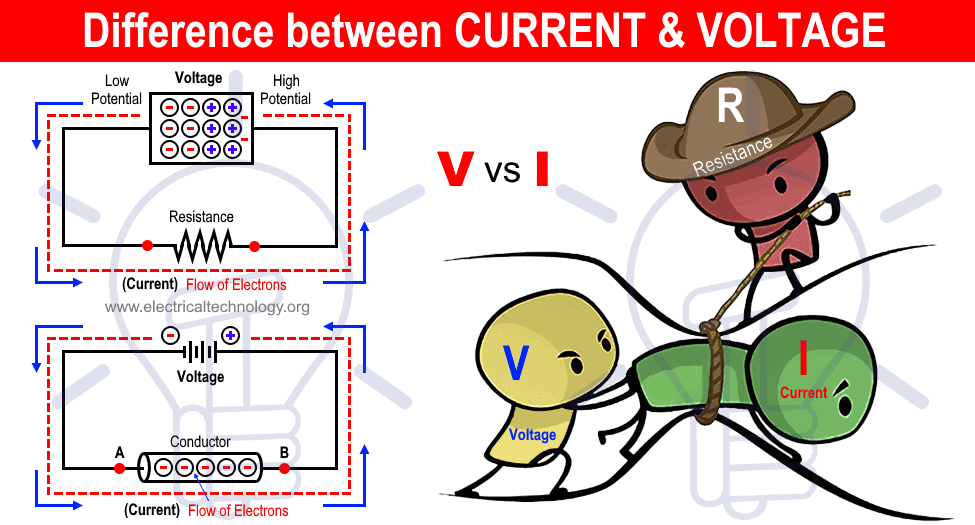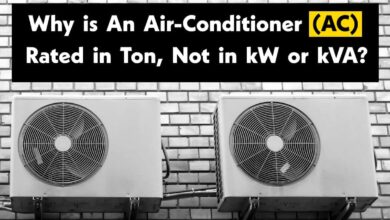Difference Between Current and Voltage
Main Difference Between Voltage and Current
Current and voltage are two different electrical antiquates but related to each other. It is important to know the fundamentals of voltage and current for electrical and electronic engineering and all those related to the electricity.
It is the most commonly and frequently asked question by beginners even in job interviews for the basic trades. We will discuss the following two basic quantities with detailed comparison.
- Current: is the rate of charge flow (electrons) between two points caused by voltage.
- Voltage: is the potential difference force between two points in an electric field which causes current to flow in the circuit.
Related Posts:
What is Current?
Current is the rate of charge flow (electrons) passing through a point in the circuit caused by the voltage. It is represented by the symbol “I”. The SI unit of current is ampere which is denoted by “A”. If one coulomb charge passes through a conducting point in one second, the amount of current is known as one ampere. A 1 Ampere (1A) of current is the 6.24×1018 electrons charge carrier.
There are mainly two types of currents i.e. AC and DC(Alternating Current & Direct Current).
AC Current: An AC (Alternating Current) changes its direction and magnitude continuously throughout the time.
DC Current: A DC (Direct Current) has the constant magnitude which doesn’t change its polarity or direction throughout the time.
The electronic current flow is from negative to positive due to vast amount of negative charge carriers (electronic engineering) while in the conventional current flows from positive to negative (electrical engineering). It is only assumed for current direction flow while solving and analyzing electric circuit although the amount of current is same in both cases.
Electric Current Formulas:
The basic electric formula for current is given below.
I = Q/t … (in Amperes)
Where:
- I = Current in amperes
- Q = Charge in Coulombs
- t = time in seconds
Current in DC Circuits
- I=V/R … (Ohm’s Law)
- I = P/V
- I = √P/R
Current in 1-Phase AC Circuits
- I = P / (V x Cosθ)
- I=(V/Z)
Current in 3-Phase AC Circuits
- I = P / √3 x V x Cosθ
Where:
- I = Current in Amperes (A)
- V = Voltage in Volts (V)
- P = Power in Watts (W)
- R = Resistance in Ohm (Ω)
- Z = Impedance = Resistance of AC Circuits
- Cosθ = Power Factor
Related Post: Difference Between Microprocessor and Microcontroller
What is Voltage?
The required amount of energy to move the unit charge from one point to another is known as Voltage. In other words, Voltage is the potential difference force between two points in an electric field which causes current to flow in the circuit i.e. voltage is the main cause and current is the effect.
Voltage is the effect of electromotive force (EMF) and represented by the symbol of V. The SI unit of voltage is “volt” which is also denoted by the symbol of “V”. A Volt is the potential difference which moves one joule of energy per coulomb charge between two points.
One volt is the difference of electric positional equal to one ampere of current dissipates one watt of power between two conducting points.
There are two basic types of voltages i.e. Alternating Voltage and Direct Voltage
Alternating Voltage: An AC voltage changes its direction and magnitude continuously throughout the time. Alternating voltages can be generated by alternators.
Direct Voltage: DC Voltage has the constant magnitude which doesn’t change its polarity throughout the time. Direct voltage can be generated by electrochemical cells and batteries.
Voltage Formulas:
The basic formula for voltage is given below.
V = J/C = W/A … (in Volts)
Where:
- V = Voltage in Volts
- J = Energy in Joules
- C = Charge in Columbus
- W = Work done in joules
- A = Current in Ampere
Voltage in DC Circuits
- V = I x R
- V = P / I
- V = √ (P x R)
Current in 1-Phase AC Circuits
- V = P/(I x Cosθ)
- V = I / Z
Current in 3-Phase AC Circuits
- VL = √3 VPH or VL = √3 EPH (Star Connection)
- VL = VPH (Delta Connection)
Where:
- I = Current in Amperes (A)
- V = Voltage in Volts (V)
- VL = Line Voltage
- VPH = Phase Voltage
- P = Power in Watts (W)
- R = Resistance in Ohm (Ω)
- Z = Impedance = Resistance of AC Circuits
- Cosθ = Power Factor
Related Posts:
- What is Electricity? Types, Sources & Generation of Electricity
- Difference between Star and Delta Connections – Comparison Of Y/Δ
Comparison between Current and Voltage
| Characteristics | Current | Voltage |
| Definition | Current is the rate of charge flow between two points caused by voltage. Or, the rate of flow of electrons is called current. | Voltage is the potential difference between two points in an electric field which causes current to flow in the circuit. |
| Symbol | Current is represented by “I” | Voltage is represented by “V” |
| Unit | Ampere – Also known as Amps, Amperage or simply “A”. | Volt – Also known as Voltage or simply “V”. |
| Unit Charge | 1 Coulomb / Second = 1 Ampere | 1 Joule / Coulomb = 1 Volt |
| Formula | I = Q / t
Current = Charge / Time |
V = W / Q
Voltage = Work done / Charge |
| Cause & Effect | Current is the effect caused by Voltage. | Voltage is the cause of current (being an effect). |
| Measuring Instrument | Ammeter (Ampere-meter) is used to measure the value of current by connecting in series. | Voltmeter is used to measure the value of voltage by connecting it in parallel. |
| Types | Alternating Current (AC) and Direct Current (DC) | Alternating Voltage and Direct Voltage. (AC and DC Voltage) |
| Field Produced | Electric Field (Electrostatic) | Magnetic Field |
| Produced by | Voltage and EMF | Generator, Alternator and Batteries |
| Value in Series Connection | Current is same at each point in series connection i.e.
IT = I1 = I2 = I3 … = In |
Voltage is different and additive in series circuit i.e.
VT = V1 + V2 + V3 … + Vn |
| Value in Parallel Connection | Current is different and additive in parallel circuit i.e. IT = I1 + I2 + I3 … + In |
Voltage is same at each point in parallel connection i.e.
VT = V1 = V2 = V3 … = Vn |
| Drop and Loss | Due to Passive elements | Due to Impedance (AC Resistance) |
| Polarity Changes | AC = Alternating Current changes its polarity while it can’t in DC = Direct Current. | Alternating Voltage changes its polarity and magnitude while it is remain constant in DC. |
| Existence | Current doesn’t exist without voltage as voltage is the main cause to flow current except theoretical superconductor. | Voltage can exist without current as it is the cause of flowing charge. |
Related Posts:
- Difference Between Active and Reactive Power
- Difference between Analog and Digital Multimeter
- Difference Between Capacitor and Supercapacitor
- Main Difference between Contactor and Starter
- Difference Between a Battery and a Capacitor
- Main Difference between Fuse and Circuit Breaker
- Basic Electronics Engineering Interview Questions & Answers
- Basic Electrical Engineering Interview Questions and Answers










A certain Inspector commanded that a 30A circuit breaker must be installed in a 2.5mm2 house wiring. What are the sizes of Circuit breakers in relation to the size of Wires?
The size of the circuit breaker must be 16 A as the safe current capacity of 2.5 mm wire is 16 Amps
The maximum distance in supply mains electricity through a transformer to a consumer is 600 on Kenya specifically. How do we arrive at this?
I think you need to remember to mention the units. 600 what? I believe it is meters. They arrive at this by calculating thermal losses via wires since at 230 volts losses are far greater than before the step-down transformer. For a given power, the lower the transmission voltage the greater the current, leading to thermal losses
I love electrical engineering, and I woona learn more about Electrical, so I think you guys I can learn from you more
Please Put some articles about some intresting and usefull circuits
I want to know many things about electrical lessons
This is very informative
THANKS